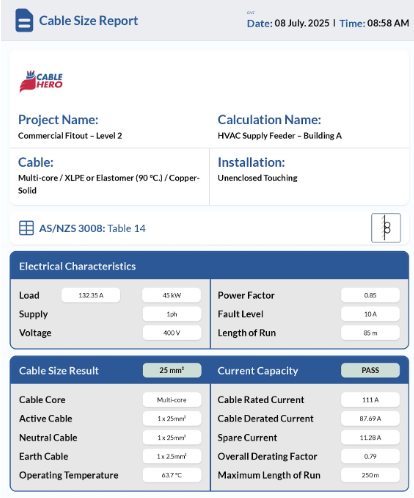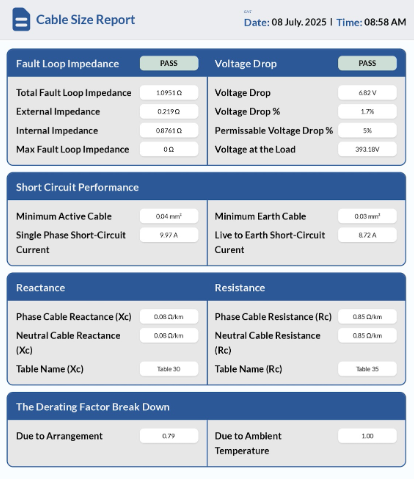The AS/NZS 3008 and AS/NZS 3000 help ensure the safety, reliability, and compliance of electrical installations in Australia. These standards govern cable sizing, installation practices, and overall system performance, reducing energy loss and preventing electrical hazards. In particular, cable sizing involves multiple variables to consider.
As such, manual sizing can lead to oversight. Fortunately, there are cable sizing calculators that align with AS and NZS standards. However, the value offered regarding the depth of automation and compliance may vary depending on professional use. CableHero is one of those tools that offers these simplified features. Here’s how it does that:
Core Features of a CableHero
Oversights can happen when dealing with dynamic or multi-load systems, especially in manual calculations. Which is why using a cable sizing calculator can simplify this tedious process. Here are the features of a calculator that ensure AS/NZS 3008 and AS/NZS 3000 compliance:
VOC Calculator
The Open-Circuit Voltage (VOC) Calculator determines the maximum voltage output of a photovoltaic (PV) string under open-circuit conditions. This is an important step in making sure that the solar system designs remain within the voltage limits as specified by inverter manufacturers and AS/NZS 5033 standards.
Calculating the open-circuit voltage helps assess scenarios under cold conditions, where voltage can peak above standard operating levels. This also ensures temperature-adjusted voltage limits to support accurate PV cable sizing. By doing so, the calculator helps prevent overvoltage damage to equipment and ensures safe, standards-compliant PV installations.
Cable Sizing
A cable sizing calculator accounts for cable length, load types, and installation conditions to ensure accurate sizing of wires among applications. It accounts for voltage drop across long cable runs, applies load diversity when applicable, and considers both phase arrangement and system type during calculation.
By supporting multi-load circuit entries, this tool can aggregate current demand to prevent undersizing and reduce the risk of overload. This eliminates manual spreadsheets and time-consuming cross-referencing with AS/NZS 3008 tables, making it a reliable and efficient solution for all electrical design.
Conduit Sizing
Apart from the cable calculator feature, CableHero also has a conduit calculator to help engineers and electricians in conduit sizing. By factoring in cable type, number of cables, and installation method, the tool ensures all calculations align with cable spacing and airflow. This significantly reduces the risk of overheating and mechanical damage.
The calculator supports both surface-mounted and buried conduit scenarios, helping users maintain compliance with AS/NZS wiring standards. It also enhances safety by preventing under-sizing, which is a common issue in manual conduit planning. With just a few inputs, users can generate accurate conduit sizing for efficient and code-compliant installations.
Auto-Derating and Correction Factors
One feature of CableHero is its automatic derating for important environmental and installation variables. This accounts for the ambient temperature, cable grouping, and installation methods in accordance with the correction factors outlined in AS/NZS 3008. These derating factors can significantly reduce a cable’s current-carrying capacity and ensure they are factored in without manual intervention.
This automated approach minimises the risk of non-compliance due to overlooked correction factors often encountered in manual workflows. It also ensures every selected cable is properly rated for its practical operating conditions.
Real-Time Cable Scheduling
CableHero automatically generates real-time cable schedules that reflect current circuit configurations. These schedules are compliant with AS 3000 Wiring Rules and significantly reduces time spent on manual documentation. Instant updates are applied when changes in load, protection, or cable size occur. This ensures there’s accuracy and efficiency in the design.
Customisable PDF Reports
Users can turn their cable schedules, voltage drop calculations, SLDs, and compliance notes into professional-grade PDF reports. These files can be shared with regulatory bodies, clients, or engineering teams for review, certification, or tender submissions. This also simplifies project workflows from design to approval.
Get Instant Results with Cable Hero
A cable sizing calculator can address the components of compliant cable sizing. From voltage drop to dynamic SLDs, these can be done in just one intuitive platform. Automating calculations and referencing electrical standards minimises human error, simplifies design workflows, and enhances project safety.
Moreover, many cable calculators align with AS/NZS 3008 and 3000 standards, and each offers a unique value proposition suited for professional use. If you’re looking for a modern calculator that’s intuitive and technically reliable, consider using CableHero. If you want to learn more, check out how our calculator works!
Frequently Asked Questions (FAQs)
Here are some questions to help explain how cable sizes are chosen for safe and compliant installations:
How do you calculate cable requirements?
Cable requirements are calculated based on the current-carrying capacity needed, cable length, installation conditions, and voltage drop limits as specified in AS/NZS 3008. Cable calculators like CableHero automate this process by applying derating factors and ensuring alignment with protection devices to maintain system compliance.
How to calculate current carrying capacity of cable?
In calculating the cable’s current-carrying capacity, the conductor size, insulation type, installation method, ambient temperature, and grouping of cables are considered. The adjusted capacity is determined by applying correction (derating) factors to the base current rating to ensure safe operation under actual environmental conditions.


